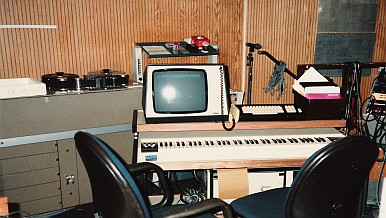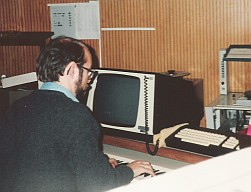|
      

Theo Rijsdijk, Fred de Beer and I were the first to work in the new studio:
SVEM, the Studio for Verbosonica and Electronic Music. In 1983 we started
planning it and in january 1984 the studio was there. It was situated in the former
VARA-studio, studio 2, an historic site, because it was the first studio in
Hilversum special built for radio-purposes. It opened in 1932. And in 1984 it
became the SVEM studio, the most modern one in Hilversum. However the
mixingconsole was still old.
The SVEM officially opened in January 1984. Ad Visser, a Dutch producer who
worked for the AVRO, was the first to work in that studio. Cees Stolk was the
musician who worked with him - actually did all the playing - and I was the
engineer. That year colleague Fred de Beer and I also worked with Konrad
Boehmer, a composer of "serious
music".
| Centre of the studio was the CMI Fairlight IIx, a great
machine, but rather expensive. There were vocoders, synthesizers, Linn
Drum and all kinds of effects equipment. But the first signs
of the upcoming economy measures were facts for us. One million guilders
was reserved for the SVEM. But the first 100.000 was spent to make Studio
2 available for the SVEM, so that left 900.000 guilders for equipment.
But the first year we could spend 100.000 only in 1983. |
 |
| With the Fairlight and other synthesizers that
100.000 was invested. So for the upcoming year 1984 we had
800.000 to spend, for instance for a new and better
mixingconsole. Wrong! We were told that there was no more
money. The amount of 800.000 guilders was scratched, before the
SVEM even opened its doors. |
|
In 1983 the Yamaha DX7 came out. We couldn't buy it, but I bought one
myself in 1984 and when I worked in the SVEM I took it with me. I used it with
the Ad Visser production and I used it for my own assignment.

One of the programs I very much liked to do was "de Taalshow". I am interested in languages and that is what this
show was all about: "taal" (language). When the program changed it's
name to "Wat een taal", they also wanted a different opening tune and I was asked to write it and play
it. I agreed to do that, because I already had a theme I thought I could use.
 |
The first day I went into the studio I decided to write a part of the tune on the Fairlight
with MCL, Music Composition Language. A very basic language that describes
music and translates it to MIDI. It took me a long long time and I never used
it after that. So part of the tune is done in the Fairlight by
programming, but most of the main tune was simply played onto a 16-track
taperecorder, as you can see in the picture. (Still got the tape, but
nothing to play it on).
(Click the left photo to hear the entire tune). |
| Of course for a radioprogram the tune must not be this long (2'32").
But this tune is set up in a way that it is easy to cut it in all kinds
of different lenghts. I actually made a tape with tunes of all possible
durations.
Because the key changes
during the tune and comes back at the original key, I made a seperate
ending in another key. This tune was actually used for the end of the
program. For the opening I had to do some additional editing with
voices.
(Click the right photo to hear the opening tune).
|
 |
But I made another tune for this program for which I used Fairlights rhythm
sequencer. The photo below shows you how that looks. If you click the photo
you hear this version. This became the opening theme for the program when the
program itself was cut from 1 hour to 30 minutes, so there was no time to
loose with tunes.

The SVEM took a lot of our time, because we were there before the customers
came and long after they went away. But I also did radioplays and all kinds of
other programs and 6 days a week were not uncommon. And the working days were
not regular hours too, most of the time exceeding 10 hours and when I did
three different jobs on one day there were usually 12 hours between goning to work and
coming back home (travel distance between work and home being 30 minutes). And
of course I also worked in the weekends, I did nightshifts and early shifts
(starting at 5:30 am) and late shifts (ending at 1 am) were common too. But we
didn't complain, because these hours were compensated too, so sometimes I
could take four days off in a row without taking up holidays.
But there were only three of us in the SVEM, so it was soon decided two
more people had to join us: Joost Brands and John van Waes.
Joost was a composer, just like me, and had synthesizers himself and John van
Waes had experience with the ARP synthesizers and did radioplays.
|


|